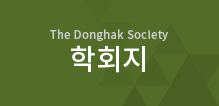pISSN: 1598-7566 / eISSN: 2713-3605
동학학보, Vol.74 (2025)
pp.133~182
DOI : 10.46639/kjds.2025.74.4
근대 민족운동 생가터의 풍수적 특성 비교 - 동학 지도자 중심으로 -
이 연구의 목적은 최제우 생가와 최시형의 피체지, 용담정의 역사 유적지에 대한 풍수적 특성을 비교 분석한 것이다. 생가지의 풍수적 특성이 동학혁명과 연관성이 있는지 연구하였다. 연구 내용은 다음 세 가지로 요약된다. 동학 지도자로 중심에 있는 최제우, 최시형 생가터 와 피체지, 용담정의 풍수적 특성 비교 분석 결과이다. 연구 결과는 두 명의 생가터와 피체지의 풍수 특성과 동학운동의 관 점에서 보는 것이다. 첫째, 최제우의 생가터는 산줄기(來龍)가 생룡의 모습으로써 풍수적 요건을 갖추고 있고, 주산에 기대고 있어 배산임수 (背山臨水)형 지세를 갖추었다. 반면에, 최시형 피체지(원진녀)의 터는 짧은 능선 지각에 동남향의 비혈지로 판단된다. 둘째, 사신사는 최제 우 선생의 생가터는 안산이 가깝고 구미산(龜尾山)의 귀봉(貴奉)이 정안 이 되어 문(文)으로 활용할 수 있다는 의미이다. 최시형의 피체지는 청 룡이 가깝고, 백호는 강하며 백호의 끝은 유정하게 집터를 감싸지 않 고 밖으로 역(逆)하고 있다. 셋째, 물(水)은 최제우 생가터는 물이 감아 주지 않고 치고 나가는 물길로, 화성배성수(火星背城水)의 기운으로, 동쪽으로 곧게 흘러 나가고 있다. 최시형의 피체지는 물길이 우측으로 거수 되어 오히려, 조안사의 우측 지형 지세가 낮게 상실된 점이다. 따 라서 두 명 모두 풍수 분석에서 물이 역(逆)하는 요소들이 있었다. 용담 정은 심산유곡(深山幽谷)의 지형으로 암반의 특성이 있는 전형적인 수 련의 터로 판단된다. 본 연구의 의의는 최제우의 사상 및 동학을 조명하는 연구 관점과 최시형의 동학운동을 통하여 연구의 폭을 넓힌다는 데 있다. 나아가 동학 지도자 중심으로 한 연구는 풍수적 비교 분석을 제시함으로써 유 적지의 지속적인 관리와 유지를 한다면 국가와 사회에 기여할 부분이 있을 것이다.
Feng Shui of the Birthplace of the Modern National Movement Characteristics Comparison : Around Donghak Leaders
The purpose of this study is to compare and analyze the feng shui characteristics of Choi Je-woo’s birthplace, Choi Sihyung’s physique, and Yongdamjeong’s historical sites. It was studied whether the feng shui characteristics of raw branches are related to the Donghak Revolution. The contents of the study are summarized in the following three ways. This is the result of comparative analysis of feng shui characteristics of Choi Je-woo and Choi Si-hyung’s birthplace and physique, and Yongdamjeong, which are at the center of Donghak leaders. The results of the study are from the perspective of the feng shui characteristics of the two birthplaces and the Picheji and the Donghak Movement. First, the site of Choi Je-woo’s birthplace has feng shui requirements as a 來 dragon, and is leaning on the main mountain, so it has a 背 forest-type geographical position. On the other hand, the site of Choi Si-hyung’s Picheji (Wonjinyeo) is judged to be a non-bloody site in the southeast direction in the short ridge crust. Second, the envoy means that the site of Choi Je-woo’s birthplace is close to Ansan, and the gibong 貴奉 of 龜尾 Mountain becomes a pavilion and can be used as a gate. Choi Si-hyung’s Picheji is close to the blue dragon, the white tiger is strong, and the end of the white tiger does not surround the house well and 逆 outside. Third, the water is a water path that Choi Je-woo’s birthplace is struck without being wrapped by water, and it flows straight to the east with the energy of Hwaseong Baeseongsu. Choi Si-hyung’s physique is that the water path was moved to the right, and rather, the terrain on the right side of Joansa Temple was lost to be low. Therefore, both of them had elements of reverse (逆) water in the feng shui analysis. Yongdamjeong is the topography of 深 幽, and is judged to be a typical site of water training with rock characteristics. The significance of this study is that it expands the scope of research through the research perspective that illuminates Choi Je-woo’s thought and dynamics and the Donghak Movement of Choi Si-hyung. Furthermore, the research centered on the Donghak leader will contribute to the state and society if the continuous management and maintenance of the historical site is carried out by presenting a comparative analysis of feng shui








